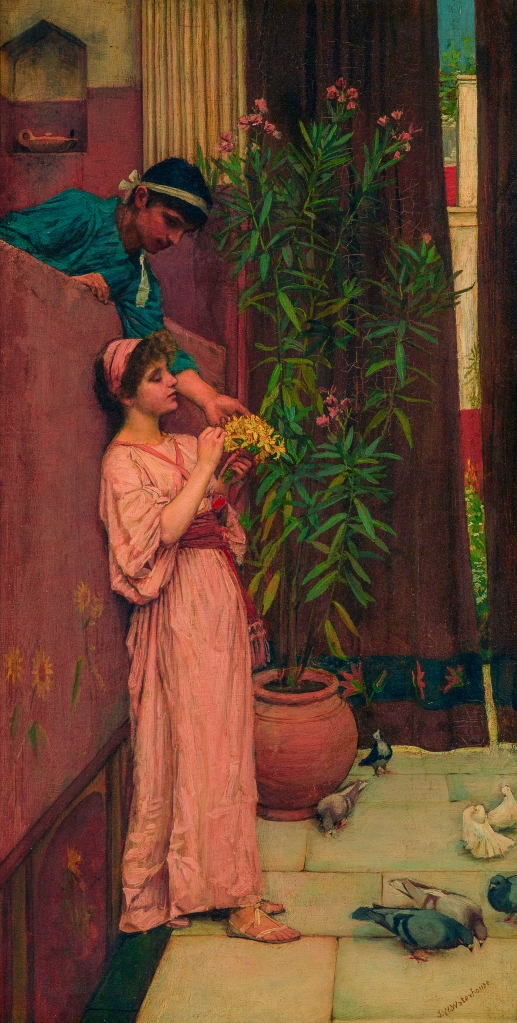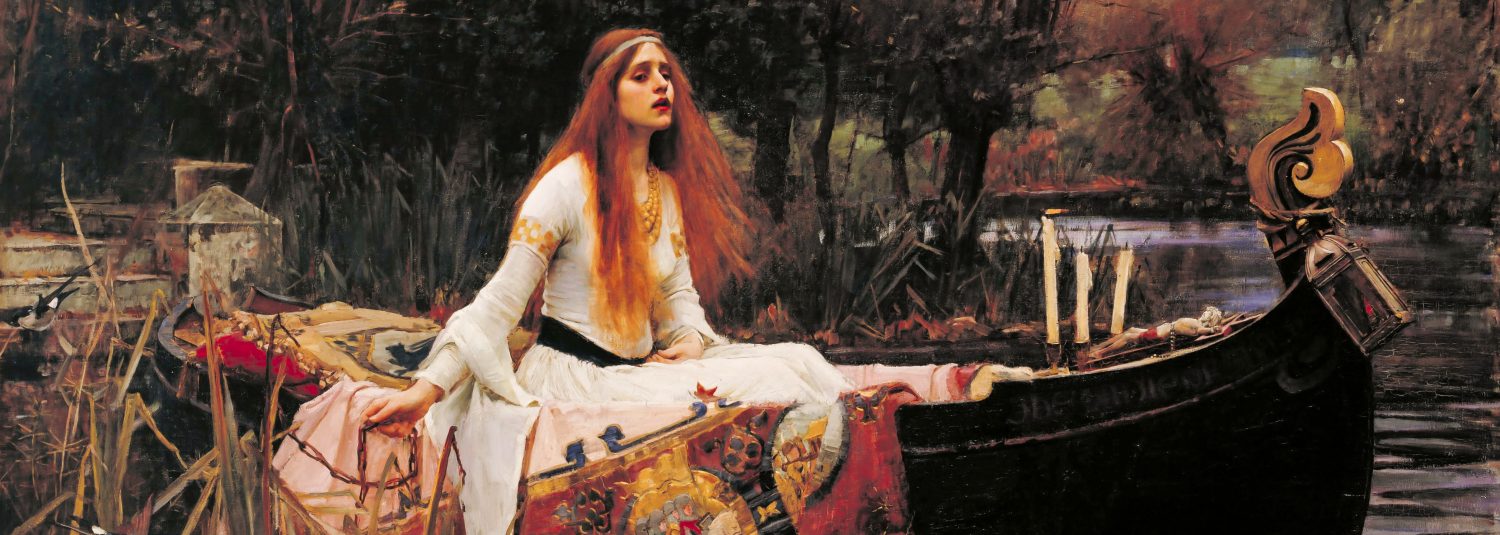
This painting is a fascinating rediscovery, epitomizing that moment in the career of J.W. Waterhouse when he had refined his distinctive mode of classical genre painting to a very high standard. The liner that separates this well-preserved canvas from its frame carries the inscriptions ‘The Courtship’ and ‘J.W. Waterhouse RA’, both of which were hand-lettered at some point long ago. There is no documentary evidence of a Waterhouse painting titled The Courtship though we know that, throughout his long career, he made many pictures for sale to private collectors which were not publicly exhibited (and thus not documented). Moreover, Waterhouse did not become a full member of the Royal Academy until 1895, by which time he had shifted to more Pre-Raphaelite subject matter. Because the present lot is undated and bears no markings or labels on its reverse, it’s place within Waterhouse’s oeuvre must instead be established by examining its subject and style.
In the summer of 1875, one of Waterhouse’s two submissions to the Royal Academy’s all-important annual exhibition was Whispered Words. Now known only through a reproductive engraving, this 40 inch-high oil celebrated romantic love, both compositionally and with a poem printed in its catalogue entry.
This couple lived some time ago,
Perhaps two thousand years or so,
Yet I am pretty sure I know
Exactly what he said.
For it was only Wednesday week
My lips were close to Jessie’s cheek,
When she looked just like this fair Greek,
And blushed as rosy red.
This verse is apparently Waterhouse’s own, since it contains the name of his own sister, Jessie. He identifies the couple as Greek, yet the scene is more believably Pompeian, a cultural setting that fascinated Waterhouse’s generation. Moreover, the facial features of ‘Jessie’ appear not Mediterranean but ‘Graeco-West-Kensington,’ a useful phrase the painter, critic and collector W. Graham Robertson (1867-1948) coined later to describe the lounging maidens of the English painter Albert Joseph Moore, ARWS (1841-1893). Moore’s Aesthetic vision of dolce far niente (sweet idleness) was pervasive in the 1870s and early 1880s, but even more influential on Waterhouse were the archeologically informed scenes of Sir Lawrence Alma-Tadema, OM, RA (1836-1912), the Dutch-born, London-based Royal Academician who had been re-animating Pompeian genre scenes since he first visited that ancient site in 1863. Waterhouse made his first visit to Pompeii in 1877, where he painted detailed watercolour studies of the frescoes and architecture that immediately made their way into the backgrounds of his finished paintings.
The young Waterhouse’s emulation of Alma-Tadema through such morose Royal Academy submissions as A Sick Child Brought to the Temple of Aesculapius (1877) and The Remorse of Nero after the Murder of His Mother (1878) was duly noted by critics of the time, but they devoted less commentary, if any, to the more charming scenes the young painter produced from the mid 1870s onward. Whispered Words set into motion a wave of gentle Pompeian reveries emanating from Waterhouse’s easel, including two versions of Dolce Far Niente (1879 and 1880) and The Household Gods (1880), as well as the present lot.
Composed, drawn, painted, and coloured with ever-increasing assurance, these comfortable domestic scenes were readily comprehensible to the upper-middle-class buyers of fine art who visited such venues as the Royal Academy, Dudley Gallery (London), Institute of Oil Painters (London), Royal Birmingham Society of Artists, and Liverpool Autumn Exhibition, not to mention commercial galleries like Agnew’s. Many Victorians saw themselves as inheritors of the Roman Empire, and they were fascinated by its material remains, which were still being unearthed on a continuing basis. It was only in 1882, with the presentation of his enormous canvas Diogenes at the Royal Academy (now in the Art Gallery of New South Wales, Sydney) that Waterhouse began to apply his classicizing expertise to a more grand scale.
There is a strong argument to suggest that the present lot is a painting entitled Sweet Offerings, a previously un-located painting, which was exhibited at the Liverpool Autumn Exhibition in 1882. In 1880, Waterhouse exhibited The Household Gods at the Royal Academy; also known as Offerings to the Gods, the work shows two young women adorning a domestic altar in a late Roman home. The work was bought by Sir John Aird, a prominent London collector who published it in a limited-edition catalogue of his holdings in 1884. Aird also owned Whispered Words, and the two large canvases hung side by side in his drawing room.
In 1879, however, Waterhouse had exhibited a smaller oil, Offerings, which shows a young woman daydreaming beside an altar that she has just embellished. This appeared at the less prestigious Dudley Gallery in London priced at just £25.
Unlocated and unillustrated until now, Sweet Offerings appeared at the Liverpool Autumn Exhibition in 1882, no.167, with the modest price of £35. By comparison, a year earlier, Waterhouse had sent to Liverpool the much larger A Summer’s Day in Greece priced at £120. The insertion of the word ‘sweet’ is significant; it is unlikely that a figure worshipping her ancestors at a Roman shrine would evoke the word ‘sweet’, as does the present picture, in which an amorous young man offers fresh narcissi flowers to his beloved. Waterhouse’s deft arrangement of their heads and arms intensifies the romantic mood, and the title Sweet Offerings would logically infer, without being vulgar, that the man worships his beloved.
All of Waterhouse’s characteristic features are here in unusually felicitous combinations: the juxtaposition of a swarthy man with a fair-skinned maiden; the delicate pastel hues of their clothing (especially the coral in her headband, sash, and gown); the bouquet of narcissi (a bloom Waterhouse celebrated throughout his career); the reddish-toned walls, one of which has been painted with the quintessentially Aesthetic sunflower; the potted plants; the magical number of seven birds pecking at grains on the marble floor; and the perspectival recession provided by the view beyond a heavy curtain into a sunny courtyard, by the oil lamp perched in the niche at top left, and by the staircase borrowed from so many Alma-Tadema compositions. Moreover, the outstanding quality of the flesh painting here would logically position this work later in Waterhouse’s career, in 1882 when he was 33 rather than, for example, when he was 27. Finally, the signature is absolutely right for Waterhouse in this era, and even the slight (and stable) craquelure visible on the leaves of the potted plant is characteristic of his hand.
– From Bonhams catalogue.
